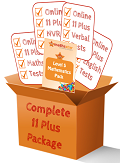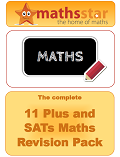|
CEM 11 Plus Tests
The CEM 11 plus tests are becoming increasingly popular with grammar and independent schools for their entrance examinations. The information below gives a few more details about the format and content of the CEM tests.
What is CEM?
CEM is the Centre for Evaluation and Monitoring at Durham University. They create a wide range of educational assessments, both paper and computerised.
Why are some 11 Plus tests changing to CEM?
CEM is non-profit, so it does not sell practice papers or practice materials. Also, the test they provide are easier to vary from year to year. This means that they are much more difficult to revise for. In a number of areas, children were being coached to pass the 11 Plus, rather than being prepared for grammar school life. This has meant that some who pass the entrance test cannot cope with the work when they move up to their new school. The CEM tests are being put in place to cut down on this problem.
Also, the tests are designed to cover a wider range of material, but with fewer tests, hopefully making it less stressful for children, but allowing a better evaluation of their ability.
What is the test format?
The tests are in the form of two papers, usually around 45 minutes each, with each paper containing a mixture of subjects, split into timed sections.
Whether the papers are standard format or multiple-choice will vary from area to area. Several of the papers contain a mixture, with multiple choice comprehension and non verbal reasoning, but standard format maths and verbal reasoning, including "fill in the gaps" exercises. Some areas, such as Bexley, will have a separate multiple-choice answer sheet. Always make sure you check the criteria for the tests your child will sit.
Which subjects are included?
This can vary from area to area. The usual combination is numerical reasoning, non verbal reasoning, verbal reasoning and comprehension. However, some schools may opt for a slight variation. Henrietta Barnet school, for instance, uses numerical reasoning, verbal reasoning, comprehension and writing skills.
What type of verbal reasoning and comprehension are included?
The comprehension tasks are multiple choice questions based on a piece of text. Sometimes, the text can be quite long, up to 2 pages. There is a mixture of questions: some ask the student to extract information from the text, whilst others require deductive skills to understand what is going on in the text or what is being implied. The comprehension tasks also include questions that ask the student what a word or phrase in the text means.
The verbal reasoning is different to the verbal reasoning found in GL Assessment papers; it is more vocabulary and literacy based. It includes:
- Similar meanings
- Opposite meanings
- Odd one out in a group of words
- Rearranging muddled sentences
- Cloze - this means filling in the gaps in a passage of text, or in a sentence
- Some of the questions may show a word with several letters missing that must be filled in to match a similar or opposite meaning.
What is numerical reasoning?
Numerical reasoning is problem-solving mathematics. In the CEM papers, several of the numerical reasoning questions are multi-part, where 3 or 4 questions make up the whole task. Others are the more standard word problems. Visit our numerical reasoning page for more details.
Where can I buy practice papers?
Remember that CEM papers are being used to cut down on 11 plus coaching, so CEM do not sell any practice papers. However, there are practice materials available if you want your child to have an understanding of the test format. CGP have produced a pack of papers - Click here to see the details. to see the details.
The main ways to prepare are:
- Make sure your child's maths skills are up to scratch and practice lots of problem-solving questions.
- Lots of reading will help build vocabulary - encourage your child to use a dictionary if they don't know the meaning of a word.
- There are plenty of verbal reasoning and non verbal reasoning resources out there. These will help your child get used to reasoning questions that they may not have seen before.
- Practice a variety of comprehension tasks. There are plenty of comprehension books available in the shops and lots of free ones online.
This website is a participant in the Amazon Services LLC Associates Program, an affiliate advertising program designed to provide a means for sites to earn advertising fees by advertising and linking to amazon.com
|




|